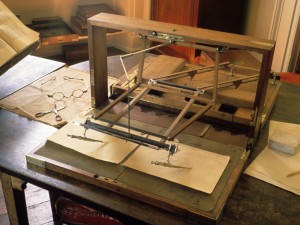Polygraph
Hawkins Invents the Polygraph
Jefferson first acquired the letter-copying device he called "the finest invention of the present age" in 1804.[1] It was invented by English-born John Isaac Hawkins, who gave it the name "polygraph." Based on the principles of the pantograph, it had two or more pens that were moved simultaneously by the writer's hand, making a duplicate copy or copies strikingly like the original.[2]
Hawkins received an American patent for his invention - which he described as an "Improvement in the pentagraph and parallel ruler" - in 1803. When he returned to England in that year, he assigned the American rights to the polygraph to artist and museum director Charles Willson Peale of Philadelphia. Peale, who was a lifelong friend of Jefferson, began production of the device, making additional improvements to it. Jefferson, who used only the two-pen models, received his first polygraph in March of 1804, soon exchanging it for another. He bought a second one for use at Monticello and regularly exchanged his machines for new ones, as Peale, often according to Jefferson's suggestions, continued to perfect the design.
Thomas Jefferson's Polygraphs
In 1804 Jefferson abandoned his copying press and for the rest of his life used exclusively the polygraph for duplicating his correspondence. By 1809 Jefferson wrote that "the use of the polygraph has spoiled me for the old copying press the copies of which are hardly ever legible . . . . I could not, now therefore, live without the Polygraph.[3]
Two of his polygraphs survive, one in the American Philosophical Society and the other on display at Monticello.
-Text written by Lucia Stanton, 9/18/89
Jefferson's Polygraph

Further Sources
- Bedini, Silvio A. Thomas Jefferson and His Copying Machines. Charlottesville, VA: University Press of Virginia, 1984.
- Monticello Collections Database. "Polygraph."
- Search for correspondence in Jefferson's papers about the polygraph.
References
- ^ Jefferson to James Bowdoin, 10 July 1806.
- ^ Confusion often arises because of the use of the term "polygraph," which is now used for a lie-detecting device. Both John Isaac Hawkins and Jefferson himself referred to Hawkins's copying device as a "polygraph," although it is what we would now call a "pantograph." According to the Oxford English Dictionary, the modern usage of the word "polygraph" (i.e., lie detector) did not come about until 1871. Before that, and even after that for some years, "polygraph" was used to refer to devices like Jefferson's, that could produce several copies of the same document at the same time. The word "pantograph" was already being used as early as the seventeenth century, but it was used chiefly amongst the scientific community, referring to very specialized instruments for reducing or enlarging mathematical diagrams.
- ^ Jefferson to C.W. Peale, January 15, 1809, in Lillian B. Miller, ed. The Selected Papers of Charles Willson Peale and His Family (New Haven: Yale University Press, 1988), v. 2 pt. 2, 1168-69. Polygraph copy available online from the Library of Congress. Transcription available at Founders Online.
